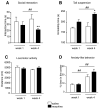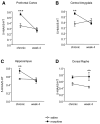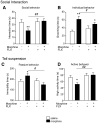Impaired emotional-like behavior and serotonergic function during protracted abstinence from chronic morphine
- PMID: 20947067
- PMCID: PMC3014999
- DOI: 10.1016/j.biopsych.2010.08.021
Impaired emotional-like behavior and serotonergic function during protracted abstinence from chronic morphine
Abstract
Background: Opiate abuse is a chronic relapsing disorder, and maintaining prolonged abstinence remains a major challenge. Protracted abstinence is characterized by lowered mood, and clinical studies show elevated comorbidity between addiction and depressive disorders. At present, their relationship remains unclear and has been little studied in animal models. Here we investigated emotional alterations during protracted abstinence, in mice with a history of chronic morphine exposure.
Methods: C57BL6J mice were exposed to a chronic intermittent escalating morphine regimen (20-100 mg/kg). Physical dependence (naloxone-precipitated withdrawal), despair-related behaviors (tail suspension test), and social behaviors were examined after 1 or 4 weeks of abstinence. Stress hormones and forebrain bioamine levels were analyzed at the end of morphine regimen and after 4 weeks of abstinence. Finally, we examined the effects of chronic fluoxetine during abstinence on morphine-induced behavioral deficits.
Results: Acute naloxone-induced withdrawal was clearly measurable after 1 week, and became undetectable after 4 weeks. In contrast, social and despair-related behaviors were unchanged after 1 week, but low sociability and despair-like behavior became significant after 4 weeks. Chronic morphine regimen increased both corticosterone levels and forebrain serotonin turnover, but only serotonergic activity in the dorsal raphe remained impaired after 4 weeks. Remarkably, chronic fluoxetine prevented depressive-like behavioral deficits in 4-week abstinent mice.
Conclusions: During protracted abstinence, the immediate consequences of morphine exposure attenuate, whereas fluoxetine-sensitive emotional alterations strengthen with time. Our study establishes a direct link between morphine abstinence and depressive-like symptoms and strongly suggests that serotonin dysfunction represents a main mechanism contributing to mood disorders in opiate abstinence.
Copyright © 2011 Society of Biological Psychiatry. Published by Elsevier Inc. All rights reserved.
Figures




References
-
- Everitt BJ, Robbins TW. Neural systems of reinforcement for drug addiction: from actions to habits to compulsion. Nat Neurosci. 2005;8:1481–1489. - PubMed
-
- Hyman SE, Malenka RC, Nestler EJ. Neural mechanisms of addiction: the role of reward-related learning and memory. Annu Rev Neurosci. 2006;29:565–598. - PubMed
-
- Shaham Y, Hope BT. The role of neuroadaptations in relapse to drug seeking. Nat Neurosci. 2005;8:1437–1439. - PubMed
Publication types
MeSH terms
Substances
Grants and funding
LinkOut - more resources
Full Text Sources

